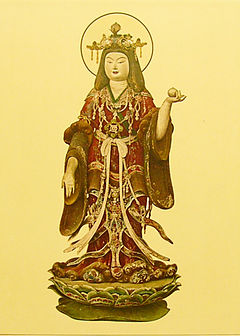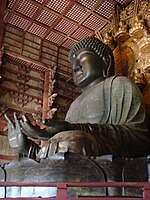Kisshōten
This article needs additional citations for verification. (February 2013) |
| Śrīmahādevī (Buddhism) | |
|---|---|
 | |
| Sanskrit | श्रीमहादेवी Śrīmahādevī |
| Chinese | 吉祥天 (Pinyin: Jíxiáng tiān) |
| Japanese | 吉祥天
(romaji: Kichijōten) |
| Korean | 길상천
(RR: Gilsang Cheon) |
| Tibetan | ལྷ་མོ་ཆེན་མོ་དཔལ།་ Wylie: lha mo chen mo dpal |
| Vietnamese | Cát Tường Thiên |
| Information | |
| Venerated by | Mahāyāna, Vajrayāna |
Kisshōten (吉祥天, lit. "Auspicious Heavens"), also known as Kichijōten, Kisshoutennyo (吉祥天女), Kudokuten (功徳天) is a Japanese female deity. Adapted via Buddhism from the Hindu goddess Lakshmi. Kisshoutennyo is sometimes named as one of the Seven Gods of Fortune (fukujin), replacing either Jurōjin or Fukurokuju.[1] For example, in the 1783 edition of the Butsuzōzui compendium (reprinted in 1796), Kichijōten replaces Fukurokuju as one of the seven fukujin.[2] She is considered to be the goddess of happiness, fertility, and beauty.[1][3] Kisshoutennyo's iconography is distinguished by the Nyoihōju gem (如意宝珠) in her hand,[4] Kisshōten and the Nyoihōju gem are both represented by the symbol of the kagome.
When Kisshoutennyo is counted among the seven fukujin[2] and fellow Fukujin Daikoku is regarded in feminine form,[5] all three of the Hindu Tridevi goddesses are represented in the Fukujin, with Daikoku representing Parvati and Benzaiten representing Saraswati.
See also[]
- Nyoihōju (如意宝珠) wishing gem
- Fukujin (福神) deities
- Buddhist Tenbu (天部) deities
- Hinduism in Japan
- Lakshmi
- Star of Lakshmi
- Ashtalakshmi
- Vasudhara (Bodhisattva of good fortune, wealth, fertility, prosperity)
- Kagome crest
- Kagome lattice
- Satkona
- Kisshō Tennyo (manga)
References[]
- ^ Jump up to: a b "Wooden figure of Kichijōten". The British Museum. Retrieved 27 August 2012.
- ^ Jump up to: a b "Butsuzōzui (Illustrated Compendium of Buddhist Images)" (digital photos) (in Japanese). Ehime University Library. 1796. p. (077.jpg).
- ^ "Kisshōten (Kichijōten)". Philadelphia Museum of Art. Retrieved 27 August 2012.
- ^ Neighbour-Parent, Mary. "Kichijouten 吉祥天". JAANUS. Atsumi International Scholarship Foundation.
- ^ "Butsuzōzui (Illustrated Compendium of Buddhist Images)" (digital photos) (in Japanese). Ehime University Library. 1796. p. (059.jpg).
| Wikimedia Commons has media related to Kichijouten. |
- Buddhist goddesses
- Fertility goddesses
- Japanese goddesses
- Beauty goddesses
- Fortune goddesses
- Japanese mythology stubs
- Japan religion stubs



